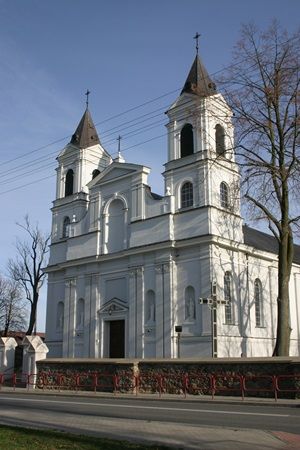St. Peter and Paul the Apostles in Suchowola
The first wooden Church of Peter and Paul the Apostles was built in Suchowola in 1791. Until 1798 it performed a role of an affiliate church of the parish in Chodorówka, but after the Third Partition of Poland the Prussians ordered to move all the masses to Suchowola, due to the bad condition of the mother temple. ‘It was an amazing celebration for the parishioners! Some altars and all the props essential for service with, undoubtedly, great splendour within three days: 23rd, 24th and 25th March, with an accompaniment with a military and civil band, and participation of 49 priests and 8 thousand of civilians.’ The wooden church in Suchowola was built on the plan of a Latin cross, tipped with a polygonal chancel collared with a vestry and a treasury. The facade was connected with a single tower. However, in time the church became too small for a growing parish. The efforts to build a new one began in 1864, but the consent of the tsarist authorities was gained no sooner than in 1878. At the beginning of the next year the parishioners began to rise a new temple by themselves. It was designed by Jakub Fordon, an architect from Grodno, father of Servant of God Friar Melchior Józef Fordon. Romuald Samotyja-Lenczewski became the construction manager; he was later the designer of many eclectic churches in Podlaskie Voivodeship. The works were finished in 1885, and on 25th August the services were solemnly moved to the new church. Its consecration took place much later, in 1905, and was conducted by the bishop of Vilnius, Edward Ropp. Very soon, though, at the beginning of the 20th century, the construction works around the temple were resumed. They included the rebuilding of the facade to make it more ‘picturesque’, which was fashionable at that time – the changes were of cosmetic nature and they consisted of enlarging the towers with openwork gloriettes, and rebuilding the triangular, classical inter-tower headstall into a crow-stepped gable with an oculus in the centre.
World War II brought major damages to the church in Suchowola. On 28th July 1944 the German army blew up the facade of the church to prevent the Russians from using its towers as observation points. As a result, the front wall of the church totally collapsed. Moreover, the parish archive – located in those towers for the time of war – was also burned down. Soon after a makeshift wooden wall was put in the place of the facade, the windows were glazed, breaches and cracks were bricked up, elements of equipment reconditioned, but the main renovation of the church started in 1947. The new facade, inspired by Jesuit architecture of the late Baroque, was designed by a Warsaw architect Andrzej Boni. He was also planning to enlarge the church with a transept covered with a dome, and to surmount the roof with a flèche, but this conception was never accomplished. The renovation was finished in 1948.
The temple in Suchowola is put on a view of a very long rectangle, with a tower massif from the west and an apse enclosing the chancel, lower than the corps. The interior, due to two rows of pillars, was divided into three aisles. The central, widest and highest of them is covered with a reinforced concrete barrel vault, whereas the side ones have flat ceilings. The exterior style costume refers to Renaissance (with the equal, monotonous row of arcaded windows in side elevations) and Jesuit Baroque (facade modelled on the Roman Church of the Gesù).
Inside the church there are three Neo-Baroque altars from late 19th century. The top storey of the main altar contains figures of the Pope St. Gregory the Great and St. Augustine, moved from the previous, wooden church. A painting of the Mother and the Child, from the same altar, is of a similar origin. It probably dates back to the 19th century. One of the most precious antiquities is an 18th-century pulpit, brought here from a church in the nearby Karpowicze, tended by the Dominicans from Krasnybór. It is evidenced by bas-reliefs covering the pulpit’s basket, depicting for example a rosary, a book and a dog with a torch in its muzzle, inspired by the Dominican iconography.
In Suchowola there is also one of the few preserved synagogues by the Biebrza. The so-called New Synagogue (Bóżnica Nowa) is situated in the north-eastern corner of Kościuszki Square, in Augustowska Street. It was erected in about mid-19th century by the Jewish community on the ground of the so-called yellow hill. It was called the Holy Ha Kodesz Beth Midrasz. After the war a school gym was located there for a long time; currently it is a disused building. This is a modest brick structure in a shape of a cuboid, in which the main prayer room for men can still be distinguished, as well as the three-room women’s gallery, above which there is a loft. Next to the synagogue there is an old Cheder, i. e. a Jewish school, which was expanded and now houses a school complex.

World War II brought major damages to the church in Suchowola. On 28th July 1944 the German army blew up the facade of the church to prevent the Russians from using its towers as observation points. As a result, the front wall of the church totally collapsed. Moreover, the parish archive – located in those towers for the time of war – was also burned down. Soon after a makeshift wooden wall was put in the place of the facade, the windows were glazed, breaches and cracks were bricked up, elements of equipment reconditioned, but the main renovation of the church started in 1947. The new facade, inspired by Jesuit architecture of the late Baroque, was designed by a Warsaw architect Andrzej Boni. He was also planning to enlarge the church with a transept covered with a dome, and to surmount the roof with a flèche, but this conception was never accomplished. The renovation was finished in 1948.
The temple in Suchowola is put on a view of a very long rectangle, with a tower massif from the west and an apse enclosing the chancel, lower than the corps. The interior, due to two rows of pillars, was divided into three aisles. The central, widest and highest of them is covered with a reinforced concrete barrel vault, whereas the side ones have flat ceilings. The exterior style costume refers to Renaissance (with the equal, monotonous row of arcaded windows in side elevations) and Jesuit Baroque (facade modelled on the Roman Church of the Gesù).
Inside the church there are three Neo-Baroque altars from late 19th century. The top storey of the main altar contains figures of the Pope St. Gregory the Great and St. Augustine, moved from the previous, wooden church. A painting of the Mother and the Child, from the same altar, is of a similar origin. It probably dates back to the 19th century. One of the most precious antiquities is an 18th-century pulpit, brought here from a church in the nearby Karpowicze, tended by the Dominicans from Krasnybór. It is evidenced by bas-reliefs covering the pulpit’s basket, depicting for example a rosary, a book and a dog with a torch in its muzzle, inspired by the Dominican iconography.
In Suchowola there is also one of the few preserved synagogues by the Biebrza. The so-called New Synagogue (Bóżnica Nowa) is situated in the north-eastern corner of Kościuszki Square, in Augustowska Street. It was erected in about mid-19th century by the Jewish community on the ground of the so-called yellow hill. It was called the Holy Ha Kodesz Beth Midrasz. After the war a school gym was located there for a long time; currently it is a disused building. This is a modest brick structure in a shape of a cuboid, in which the main prayer room for men can still be distinguished, as well as the three-room women’s gallery, above which there is a loft. Next to the synagogue there is an old Cheder, i. e. a Jewish school, which was expanded and now houses a school complex.













